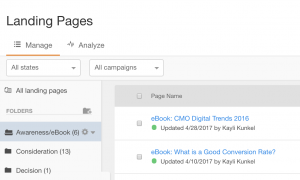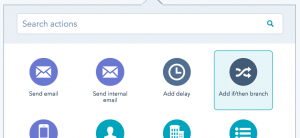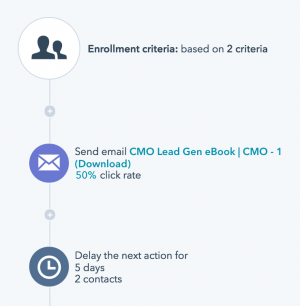
HubSpot is a powerful marketing automation software. So as you plan your next big marketing idea, you want to use HubSpot campaign best practices to truly take advantage of this tool:
Marketing automation users report three times more leads passed to sales after one month. – Marketo
Here are major considerations when you set up your campaigns in HubSpot (or in any automation tool).
 You can also use folders in several HubSpot screens to organize your campaign materials, like landing pages.
You can also use folders in several HubSpot screens to organize your campaign materials, like landing pages.
This might seem elementary. But this simple trick will make your campaigns much more organized, and therefore measurable. And measurable campaigns will help you scale your success (and optimize your shortcomings) to make your future campaigns even better.
So as you start to gather all of your elements in HubSpot — calls-to-action, landing pages, blog posts, and more — make sure you use one concise name.
For example: eBook: [Full name of campaign] | CTA
To go even farther with HubSpot campaign best practices, make sure each of your campaigns follows this pattern. You can name things according to:
Or any other organizational system that helps you. Hyphens and pipes (|) can help you stay organized and move quickly.
Don't use different versions of your campaign name. (For example, "IT Lead Generation" and "IT B2B Leads.") This might be fine in the short-term when your memory is sharp. But when you go back to reference it months later, you will find yourself confused and lost for important analytics.
 If you're sending your offer in a follow-up email, make sure you write this email and attach it to a workflow before hitting "publish" on any promo work.
If you're sending your offer in a follow-up email, make sure you write this email and attach it to a workflow before hitting "publish" on any promo work.
It might be tempting to start blogging immediately when you have a campaign in mind, or writing clever social media posts.
But since B2B lead generation is probably the most important reason for your campaign, you should start first with your lead generation offer.
Specifically, nail down the tone, voice, goal, and audience of your eBook piece. Then you can start working your way up the campaign:
And then you can work on the content strategy to promote your offer — blog articles, social media posts, repurposed pieces like slideshows, emails, etc. to get the word out.
By working your way up instead of down, you make sure that your value proposition stays strong throughout the whole campaign journey. And value is arguably the most valuable part of lead generation, anyway. (For help on campaign strategy and your value proposition, contact a HubSpot agency.)
A campaign shouldn't exist in a bubble. And even a really great campaign or content offer idea should be reactive to a certain segment you're trying to attract.
 Before you publish your campaign, you should assess which "next steps" will be relevant for anyone who engages. Then, you can create a follow-up workflow to move people even farther through your funnel.
Before you publish your campaign, you should assess which "next steps" will be relevant for anyone who engages. Then, you can create a follow-up workflow to move people even farther through your funnel.
Therefore, for each HubSpot campaign, you should do two "big picture" things:
When you answer these two big questions, you create some very clear first steps for your new HubSpot campaign.
For example, you will know where to promote your campaign, since you've identified the right audience segment. Specifically, you could send an email promotion to a list of contacts who've you've already identified in this segment.
Lead nurturing emails get 4-10 times the response rate compared to standalone email blasts. – DemandGen Report
And you will also know which kind of workflow you'll need to create as a follow-up campaign — AKA, which next steps you need to drive, and where to focus afterwards.
In this article, you learned to follow an organizational system, build your value proposition from the "bottom" up, and maintain context around your campaigns.
These HubSpot campaign best practices will help you do what you do best — strategize marketing ideas for your audience, and drive return and results.
Sources
https://www.marketo.com/reports/calculating-lead-nurturing-roi/
https://www.demandgenreport.com/industry-topics/demanding-views/2336-the-10-commandments-for-lead-nurturing-success.html#.U6m75PldV5p
by Jonathan Franchell, CEO of Ironpaper - For more tips and hacks: Need to remove a new line after h1 tags? Both web designers and SEO practitioners need to employ headline tags: H1, H2, H3 in several ways to improve web page structure and tag...

The marketing industry is transforming significantly due to generative AI and increasing market complexity. Gartner's prediction of a 25% decline in traditional search traffic suggests that the era of search engines is dying. AI tools, particularly...

The Crowded Arena of the IT Marketplace Updated December 2024 The Information Technology (IT) landscape is experiencing rapid growth and intensifying competition. IT spending is projected to reach nearly 5.1 trillion U.S. dollars in 2024, a...

Updated December, 2024 The field of digital marketing is evolving rapidly in response to new technology and changing buyer expectations. To help career-minded marketers, we’ve rounded up the top 10 skills needed to succeed in the field. These are...
